I’m back from St. Louis. Despite growing up in nearby Chicago, I had never been to St. Louis. In my mind, I was thinking the Baltimore of Midwest: Faded industrial glory, local pride, and the answer to one of my own favorite personal trivia questions: What city of a certain size (at least a couple hundred thousand? or perhaps with a major league sports team?)has lost the greatestpercent of it’s population?
The answer?
No, not Baltimore.
Not Detroit.
Not Newark.
St. Louise, M.O.
Yes, St. Louis. From 856,796 people in 1950 to 353,837 today. Almost 60% of the population left.
Why? Of course the usual economic and social reasons. But something had to be different about St. Louis to lose mostof it’s population.
We arrived by train from Chicago. I had St. Louis Union Station mapped out. Silly me thinking that trains actually arrived in the beautiful train station.
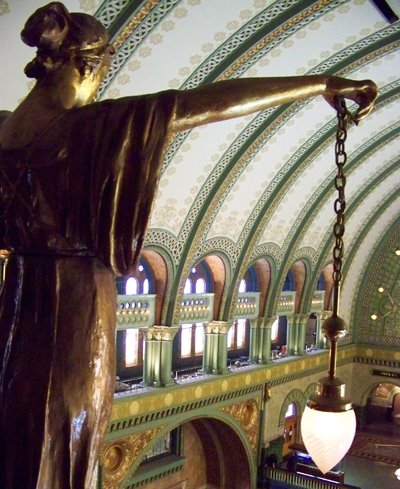

Instead Amtrak pulls up next to one of those Amtrak Shacks. Except it was dark and rainy and muddy when we arrived. Sigh.
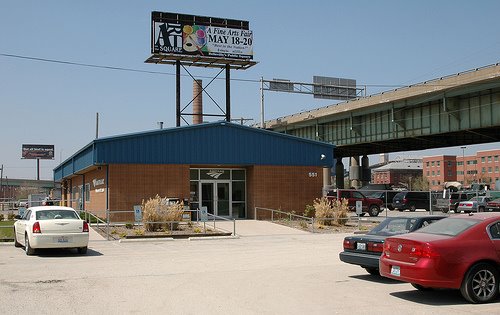
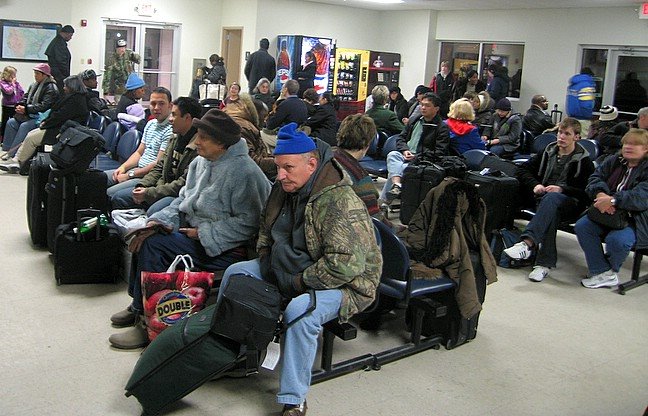
 A bad train station alone does not a deserted city make. The sad part is that St. Louis, which does have some very nice parts, coulda been a contender. The city doomed itself in the 1930s when they tore out the heart of the city. Part of this area would, in the 1960s, because the St. Louis Arch (or more ominously officially called the Jefferson National Expansion Memorial). The Arch, by the way, is beautiful.
A bad train station alone does not a deserted city make. The sad part is that St. Louis, which does have some very nice parts, coulda been a contender. The city doomed itself in the 1930s when they tore out the heart of the city. Part of this area would, in the 1960s, because the St. Louis Arch (or more ominously officially called the Jefferson National Expansion Memorial). The Arch, by the way, is beautiful.
I guess destroying your city in the 1930s was cutting edge urban renewal at the time. Most cities didn’t tear themselves down till afterWWII. In St. Louis, the old courthouse used to be in the center of the city. Now it’s almost on the Eastern Edge surrounded by some ugly hotels and office buildings from the past few decades.
The old basilica used to be surrounded with glorious cast-iron buildings. Now it’s surrounded by nothing. Why do they do that? What were they thinking? Why do they still do that?
Probably about a whole square mile is gone. And it’s the part with history and character. Like Soho in New York. It’s gone. All of it. Now there’s the Arch area. OK. Fine (though there would be nothing wrong with an arch rising out of real neighborhood). And the rest? Now there’s a freeway. And empty spaces. And lots of parking. Too much parking is always a bad sign.
From the arch you can see the huge space that used to be city.

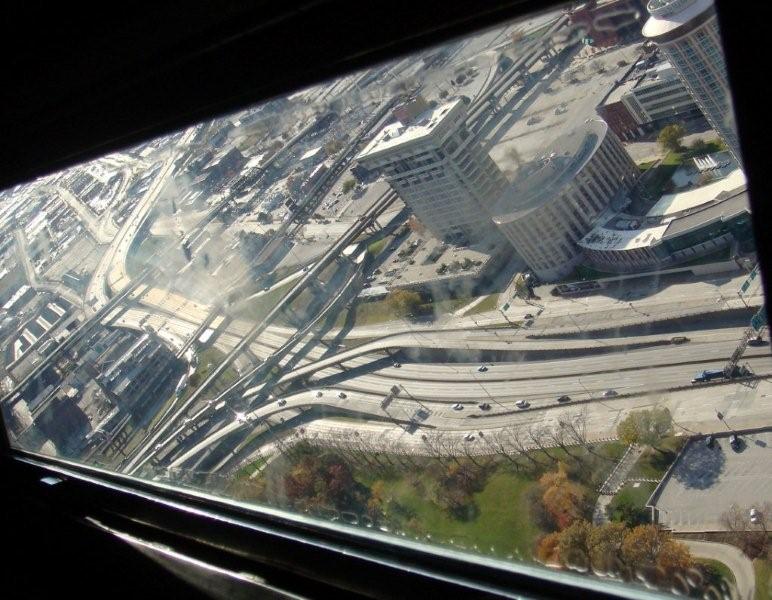
There are just a few buildings in this area left. 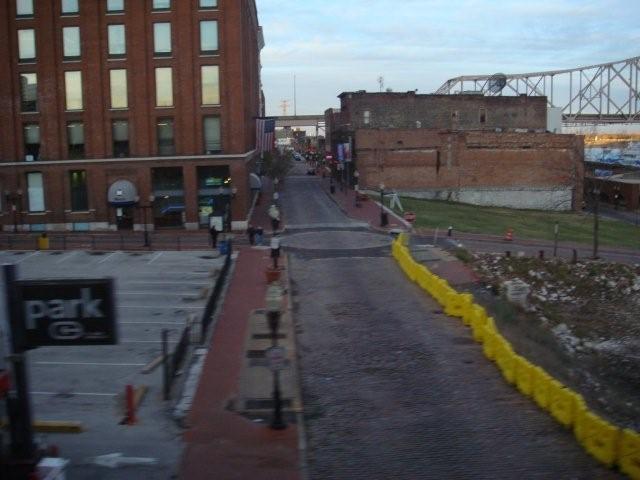 The buildings that are left look like this. Gorgeous.
The buildings that are left look like this. Gorgeous.
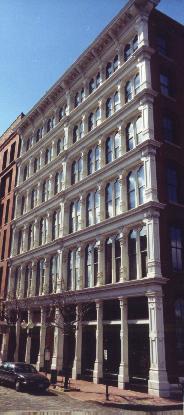
What’s left is filled with a predictable blend of mediocre restaurants and sports bars in an attempt to bring nightlife back to the city.
St. Louis could have been the New Orleans of the North. But they torn down their French Quarter. Instead, well imagine New Orleans without the French Quarter. Or, for that matter, good food or music.
I didn’t get a chance to see North St. Louis, where that half of the city that fled used to live. But in the brief time we had before our flight out, we were able to take the nice St. Louis Metro to Illinois and back. I wanted to see East St. Louis, even if a classic “slumming tour” just through the window of a light-rail train car.
East St. Louis, Illinois, is perhaps the single most f**ked up city in America (and there is tough competition). They lost their city hall in a lawsuit around 1990. That was their only asset. If you’re interested or worried about this kind of thing, you should read Jonathan Kozol on East St. Louis.
Crossing the Mississippi River, you see the casino, the talisman of attempted economic revival: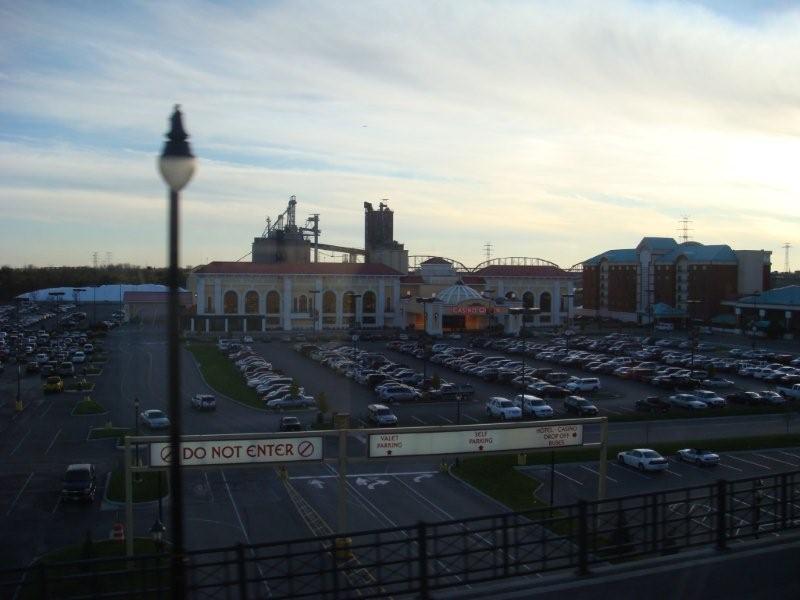
Then you see how there’s just no there, there.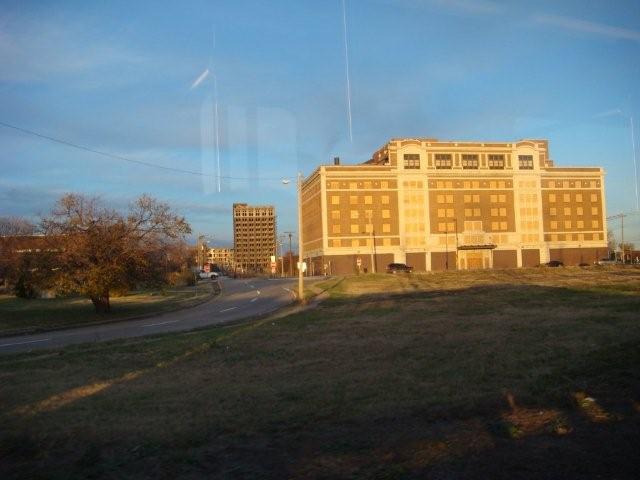
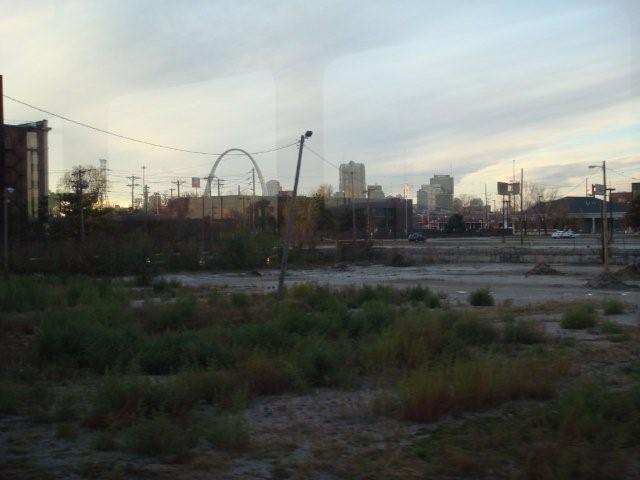 The arch rising in the distance. Yeah, I know it’s not the most subtle use of juxtaposition.
The arch rising in the distance. Yeah, I know it’s not the most subtle use of juxtaposition.
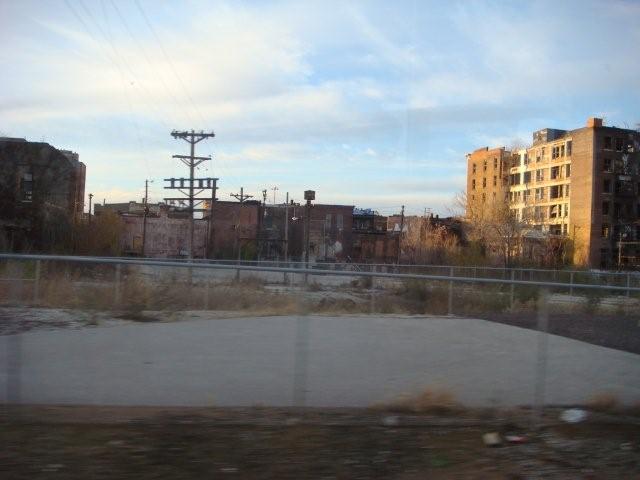
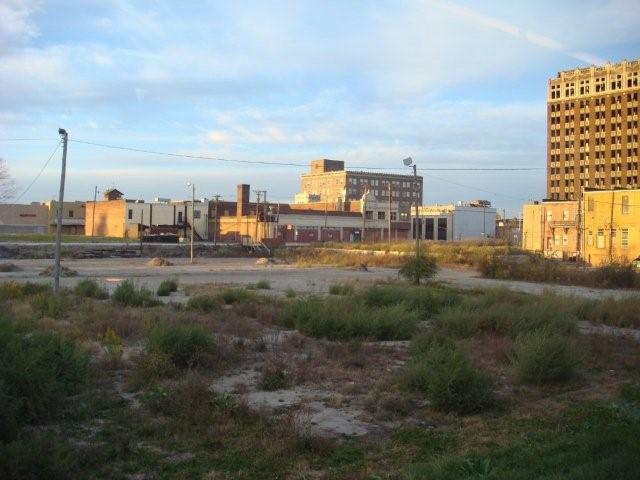 Downtown East St. Louis.
Downtown East St. Louis.
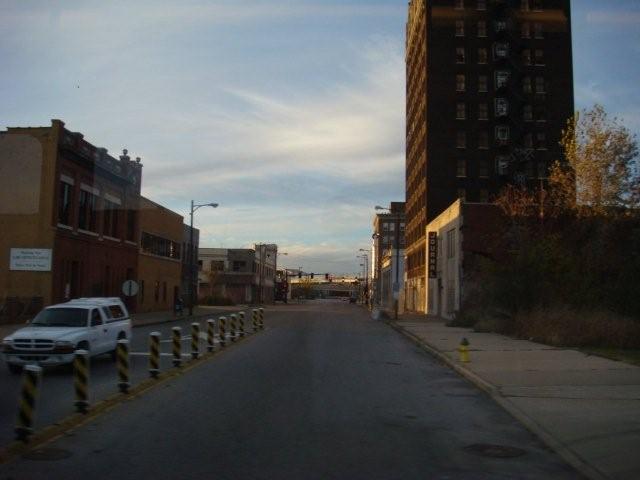
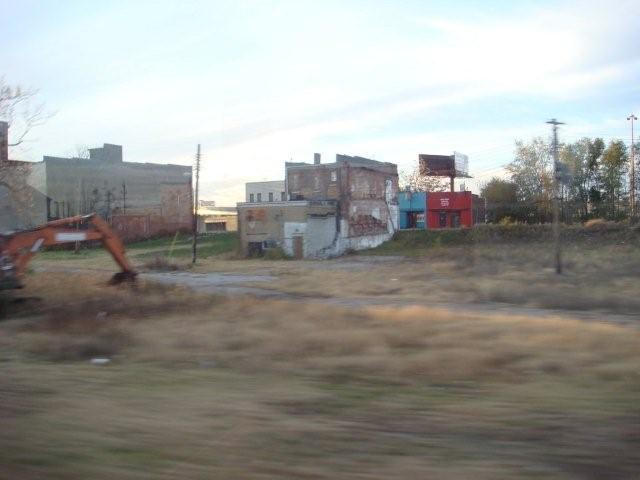
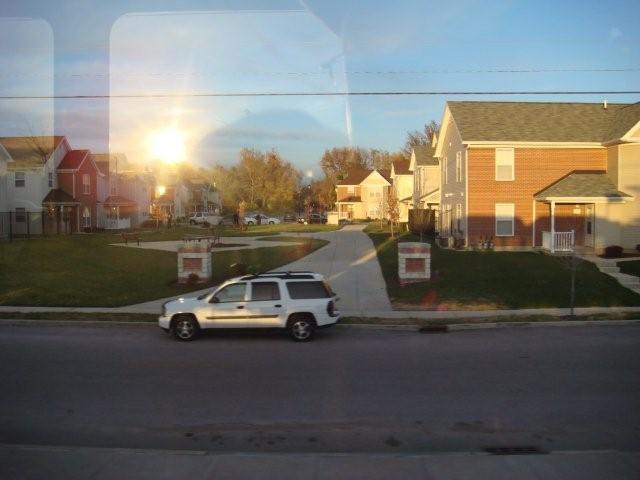 New development.
New development.
What the morale? I don’t know. Why do we let this happen? And if you think your city is in trouble… just remember, it could always be worse.
[December 10 addition: Just remembered that part of the reason we got on the light rail was to find a place to eat. The employee at the station told us authoritatively: “There are no restaurants in Illinois.”]

I am from St. Louis. My dad repeated to me as a child the “St. Louis could have been the New Orleans of the North” line so often that I wondered if he was full of it. Maybe he was or wasn’t. But St. Louis’ urban development can be summed up in two simple words: Pruitt-Igoe.
Her city leaders have always thought top-down. They don’t get that a city has to have more than that. No amount of casinos or arches or stadiums can create a community.
I am glad you made it to StL. You missed some of the midtown area that is really the heart of the old city. Forest Park and the Central West End are absolutely better than NO’s Garden District. Hope you can make it back.
I thought I just coined that “St. Louis of the North line.” My props to your dad! I did not know until a few days ago that St. Louis was a Catholic French city settled from the South. I didn’t know much at all about St. Louis, with my Chicago-centric upbringing.
I did actually spend a lot of time (given how briefly I was in the city) in Forest Park, Central West End, and the Grove (my wife has friends who live there–but I think they called it Forest Park Southwest). Better than the NOLA’s Garden District? Fighting words to some, I’m sure. But I’ll grant you it’s in the same league.
Newstead Tower Public House on Manchester Ave is wonderful (I wish it were in my neighborhood here in NYC!). And we saw the new Bond movie at the Moolah. What could be finer?
So I’m sorry I grouped all the good parts of St. Louis into a brief part of a sentence (“which does have some nice parts”)! I do not do the city justice.
But oh, it could have been so much more… it could have been a contender.
One note to the numbers of people who appear to have left St. Louis -the growth of the city moved largely west and suburbs have exploded and are thriving between I-70 and Hwy 64/40 and beyond. The statement as presented makes us sound like “would the last one out of the city turn the lights out!”
Downtowns in many areas are suffering and getting to revamp and rebuild. With lower tax bases it is a difficult situation but there are pioneers who are taking advantage of tax incentives to restore buildings for living spaces in addition to corporations that are replacing or redoing current buildings.
You may not have seen what the waterfront was that was torn down to make room for the Arch and other destinations, but we didn’t lose anything there. Trust me!
Nice pics and thanks for visiting. Do come back and visit The Hill, the Botanical Gardens, and many of the 80-something neighborhoods that the inclusive term, St. Louis represents.
“East St. Louis, Illinois, is perhaps the single most f**ked up city in America”
Indeed. Incidentally, if I recall correctly, the Illinois State Police have had to completely take over policing in East St. Louis on at least one occasion due to corruption/financial problems in the P.D. and city in general. I recall hearing that the floor boards had fallen out of squad cars, but the mayor had a five officer security detail. Nice.
During a crime scene internship, I completed w/ ISP, they offered to send me down there for awhile. The people from Crime Scene Services assured me that I’d “see a lot.” I nodded, smiled, and stayed in Central Illinois for the rest of my internship. Experience is one thing, but third world conditions in the American midwest would have been a bit too depressing for me, and I currently work in a regional trauma center!
Jojo,
I *do* mean the statement to sound like “would the last one out turn off the lights.”
I understand that the suburban region is thriving. But that doesn’t do enough to help the city. I understand the very good reasons that people leave the city (crime, taxes, schools).
But growth in the county doesn’t help people in the city. In many ways, by decentralizing the region, growth in the suburbs makes city life worse–especially for those without cars.
The city/country distinction (just like in Baltimore, by the way) is huge. Tax dollars in one don’t go to the other. The result? People in the city pay more for less. It’s not right. Why do we consider our nation’s poor to be the responsibility of the city they live in? Why should we be able–and even rewarded–for moving away from our problems?
There’s a huge difference is city services and schools between county and city. Just because you can run away from city problems doesn’t mean you should.
And I did see pictures of the downtown area before 1930. It was beautiful. Tearing it down was a huge and irreplaceable lose. And “slum” or not at the time, had it survived, the city would never consider tearing it down today.
I walked through downtown St. Louis on a Sunday and saw not a soul on the streets. I would gladly take whatever was there before.
In NYC, they wanted to tear down Greenwich Village in the name of freeways and progress as well. Jane Jacobs (and others) stopped them. Now we can’t imagine the city without the Village and Soho. They simple do not build those buildings anymore. And though they could, they simply do not zone for small plots and mixed use that allows for people-friendly neighborhoods that thrive without some developer’s idea of a master plan.
Look, I’m not trying to St. Louis is a bad place. I’m trying to say that it represents so much of what has been wrong with urban planning, policy, and historic preservation. These forces affected all cities in the U.S. It’s just that some got hurt more than others. Today half of St. Louis is vacant or boarded up. It didn’t have to happen. Demolition and suburbanization of our cities is not the answer.
And as a man who loves cities, I just find it sad.
Dr. Moskos,
Looks like you just missed a major change.
stltoday.com/stltoday/news/stories.nsf/stlouiscitycounty/story/8EEA2570476B96EE862575060015ACD0?OpenDocument
A day late and a dollar short. But it still ain’t no Union Station.
Still, I do like the Mondrian inspired windows.
PCM,
There are some insightful and valid criticisms in your piece, and these are precisely the same reasons why I was negative toward St Louis when I moved here about 10years ago. I understand that you mean St Louis to be an example of what we (the US) could have done better for our cities over the years, and I agree. But there are myriad, subtle gems here that indeed redeem (CWE, Forest Park, the Gardens, Soulard, Lafayette Square, the Basilica, just to name a few) and which are not obvious to the casual traveler. (Did you even see the grain-matched marble in the Basilica? This is only bested by St Peter’s, in my travels.) Nowadays I have grown to like its redeeming qualities (exceptional vernacular architecture, for one).
When I stepped back and took a critical look at your arguments, I wanted to ask a few questions: You mentioned that downtown was bare on a cold Sunday afternoon? Are there that many people out in TriBeCa on a cold November Sunday afternoon? Even in our rundown downtown, Wash Ave is alive and kicking, and clearly more so when it’s warm. Did you go there? (I mention Tribeca b/c I was in a section there recently and thought how devoid of people it was.) There are sports bars galore in Chicago, but we don’t say that it’s a mediocre eating town, of course. Did you attempt to go to any of our well-respected or new bistros (Niche, Sidney-Street, American Place, Herbie’s, lots more)? They may not be in DB Bistro’s location, but critics might like ours more. If I were doing a piece on Manhattan and showed lots of bombed-out photos of Jersey (as you did of East St Louis), would this be an accurate depiction of the life of New York? Is the New Orleans riverfront your idea of the paragon of non-crime, good taste, and historic preservation? We clearly have work to do on our riverfront, but I wouldn’t hold the Big Easy’s mud, casino, and elevated walkway up as the best model.
If I had the choice of all cities to live in without regard to employment or cost, I would likely not choose St Louis. But I think your piece either took too cursory a look at the city or was too eager to make St Louis an example of pre-decided criticisms of urban life.
Respectfully,
Dr. J. Woods
Dear Dr. Woods,
Thank you for taking to the time to leave a thoughtful and well written response.
I am always surprised that anybody reads my blog. I really never expected anybody from St. Louis to read my blog. But that, I suppose, is the wonder of google. And I’m proud that there is such St Louis civic pride!
I mean, I’ve already written enough bad things about Baltimore. And I love Baltimore! My goal here is less to give St. Louis a fair shake than to provide impressions on urban decay in America using St. Louis as an example. Pointing out the bad doesn’t mean there isn’t good. I would say you’re spot on with the line: “pre-decided criticisms of urban life.” I might rephrase that to say “confirmed many of my beliefs on the horrible and purposeful destruction of urban infrastructure and life.” But your point is still valid.
Believe it or not, I actually *did* see the grain-matched marble in the Basilica. And though I generally subscribe to the Mark Twainian “you seen one cathedral, you seen them all” attitude toward churches, the basilica was outstanding (I am a bit biased toward Byzantine aesthetics). And the little museum in the basement is top-notch.
I know East St Louis isn’t St Louis. But as an outsider, they’re both equally interesting. And growing up in Illinois, I was always fascinated with what was going on in East St Louis in the 1980s and 1990s.
If you were doing a piece on Manhattan and showed lots of bombed-out photos of Jersey, it might not be an accurate depiction of the life in New York City. But it would tell you something about the region. And it could be an accurate description about the life of people who live in the slums of Jersey. And I, for one, would love to read such a piece.
I don’t think every reference about a place needs to be fair and balanced. I say that not out of laziness or spite, but because it is the underbelly of society that needs more sunshine. People can buy guide books telling them about the basilica and tourist-friendly or shiny parts of a city. I prefer to write about the troubled side, the side that is less written about, the side that most needs change and improvement. This is, quite frankly, the side that needs attention.
While it may not be fair, it seems better to shine light on the negative than simply ignore it or pretend it doesn’t exist. For instance, I never did see North St Louis. “There’s nothing there,” I heard. Well I don’t know what is there, but I guarantee there’s something. Or recently my mom was in Savannah and was told by somebody in her hotel, when pointing to a part of the city map, “we don’t go there.” Oh, don’t “we”? Well, I want to go where “we” don’t.
If anything, I like to think of some of my writing is inspired by the photographer Camilo Jose Vergara. I love his work. He shows urban decay. And change and renewal too. Sometimes, by highlighting the negative, one can illustrate a greater truth. Plus, it’s often very beautiful. I don’t want my writing to hurt people. I want to start a discussion. I want to help make things better.
I want to people to read my writing and 1) well, reading it is number one, 2) enjoy what they read, 3) think about what I wrote, 4) learn from what I wrote. Way down on the list would be “agree with what I have to say.”
It seems to me, especially with some people still defending the destruction of old St. Louis (and other cities), that too many people still haven’t learned the lessons of urban destruction from the past. I’m not saying that nothing should be torn down. But I do believe, nine times out of ten, that when old (Pre-WWII) buildings are urban design are destroyed, whatever takes their place will be worse. And in places with so much vacant land, why does anything need to be torn down to build new?
Dr. Moskos,
You do a public service by bringing negative urban qualities to light and by fostering discussion of urban decay/destruction in the U.S. Those of us who live in urban centers (and who clearly want them to thrive) benefit by said discussion. In this vein I hope to continue the exchange and offer the following heartfelt comment/criticism:
I’ve thought at length about your St Louis piece, my short comment and your response, and there’s been a small stone in my shoe ever since. Something about the original prose and responses has bothered me, and finally I think I can articulate what that is. I think that, in essence, you’re arguing that even though your criticisms of St Louis may not be exactly fair or accurate, they’re still valid. (Said differently, I fear you think it is acceptable to use factual inaccuracies in making a criticism of a sociopolitical issue, if there are resonant and/or accurate points in the argument.) As an academician (and physical scientist), this offends my sensibilities at their core. If you were indeed writing about urban problems in New York for example, then mentioning how few people were on the streets in Tribeca on a cold Sunday afternoon and showing dilapidated buildings in Jersey City would clearly illustrate a point, and it would resonate with readers. But it would be inaccurate of and unfair to Tribeca. /Every/ urban area has an ephemeral mixture of renewal and decay, and some cities in the middle suffer from more decay than some on the coasts (often b/c of the lack of geographic restrictions on areal expansion). From your blog, “My goal here is less to give St. Louis a fair shake than to provide impressions on urban decay in America using St. Louis as an example.” St Louis deserves criticism, but it should be accurate: e.g., when you said that half of St Louis is vacant, you probably meant /parts/ of north St Louis City, which would comprise a small fraction of the urban geographic area. And you admittedly didn’t visit this part of town—the part with widespread, true urban decay. (I go there from time to time when offering a friend a ride to his home from mine, south of downtown.) Or talking about a muddy Amtrak shack when it was likely obvious that the new Mondrian-inspired Amtrak/bus/Metro center was being built. Or the quote, “But they [St Louis] tore down their French Quarter.” The ‘French Quarter’ of St Louis is still standing—Soulard—and is the center of a lively urban nightlife and music scene, not to mention the 500,000+ people who show up for Mardi Gras every year.
You see, I have no particular reason to defend St Louis to coastal troglodytes other than the fact that I am offended by unfairness and inaccuracy. I did not grow up in the Midwest and I have no inherent, unfounded “civic pride” that you refer to. I agree with the larger sociopolitical arguments you make about urban decay/destruction. What is clear, however, is that those of us who strive to make our urban centers more functional, prosperous, and pleasant will continue to suffer from the furtherance of inaccurate “coatrog” stereotypes. Perhaps Midwesterners should adopt a more aggressive stance in contradiction of said stereotypes. I suspect that you wouldn’t write such a piece on Lower-East Manhattan and use e.g, Queens as evidence of an otherwise valid point. It would be the same type of unfairness and inaccuracy as I cite above, but you’d likely offend one of /your/ friends or colleagues and receive more than one letter like this from an irked reader.
Dr. J. Woods
Dr. Woods,
Fair enough. You write valid criticism.
And I really do appreciate your thoughtful comments.
But what can I say? These were my thoughts on a brief visit to a city I didn’t know very well.
My post is also not a scientific study of St. Louis and I really don’t want it held to the same standards as some academic paper.
Perhaps it would have been fairer to make two different posts: one for St. Louis and the other for East St. Louis. But that really didn’t occur to me. And I did it a clear distinction in my writing between the two. I didn’t post picture of East St. Louis saying it was St. Louis. And I don’t see why it’s wrong to mention the two cities in the same post.
I also find it interesting that of everything I’ve ever written, this piece has gotten the most comments (or at least lengthy and thoughtful comments).
I’m not certain what that means. I’ve written far more negative things about Baltimore but most Baltimoreans just nod their head and go, yeah, true dat.
And the simple truth is New York City simply does not have the decay of other cities. There is no neighborhood in New York City that matches the crime and blight of parts of Baltimore, St. Louis, Camden, Philadelphia, or Washington D.C.
I’m not certain why that is, but I suspect, that parts of what makes New York City great–immigrants, tolerance, true diversity, public transportation, progressive social values–are ingredients that other cities would and could do well to emulate as a recipe for success.
I didn’t visit North St. Louis. I would have liked to. Though I doubt a visit there would have inspired me to write more hopeful things about the city.
And I did see the Mondrian Station. But it wasn’t open. Had it been, I would have been happy to say nice things about it. But I arrived at a very muddy shack with racist graffiti in the bathroom (that might sound like petty complain, but I honest can’t remember ever seeing racist graffiti in a bathroom, especially in a public bathroom).
I don’t see the world through rose-colored glasses. I don’t think anybody who has ever policed does. You’ll notice in my other posts I don’t talk about Baltimore’s Inner Harbor or the leafy parts of North Baltimore. I choose to write about the down-and-out parts of cities both because I find them more interesting and because I think they more need our attention.
And St. Louis did tear down a gigantic chuck of their old downtown. I’m happy Soulard still exists. But that doesn’t mean it wasn’t a mistake to destroy much of the city with misplaced visions of freeways and destructive “urban renewal.” I don’t quite understand why my failure to mention or weigh the better parts of St. Louis makes my criticisms any less fair. And I guess why it me so much because so much of the destruction of St. Louis was by choice.
To make a New York analogy, it would be like me writing mournfully about the destruction of Penn Station and somebody criticizing me because I failed to mention how beautiful Grand Central is. Well, Grand Central is beautiful, but that doesn’t make the demolish of Penn Station any less tragic or real.
And I might be a troglodyte, but I’m not a coastal troglodyte. I’m from the Midwest and grew up relatively close to St. Louis (in Chicago). Yes, I’m biased toward New York. But only because having grown up in many other places, I think New York is a wonderful city and a great place to live. By American standards New York is sort of the Ur-city.
And I too strive to make our urban centers better. I really plead no contest to perpetuating stereotypes of St. Louis because I simply had no preconceived vision of the city.
Overall, I can’t help but think that despite our disagreements here about the focus of my writing in this post, I suspect we’re actually much more in agreement on what makes a city good.
Maybe this is part of why theres so much homeless jobless people in st.louis. if there tearing all the building down closing up and moving somewhere else. I am if they the city is mote the buildings it is people there are still people there maybe forgotten people homeless people no one eants to think about. But with out jobs it's going to stay that way. And no jobs more crime. It cost to ride a bus if thetes no jobs no buildings to irs ok.
Some of those building havent been keep up.or repaired by the owners and had to be abanded because there condemned.
Peopke don't want to live in parts of chicigo and parts of new year. Either. When the people go where less crime is the business are going to go too.The high maybe part of it it very noisey and lots of traffic too. Its not the schools that are bad or the teachers . Yeah alot of the schools are ilder buildings too. Some of them are closed long before now. It started when they started moving the kuds around and there was gun brought to school and ganfmg fights ect. Decegragtion. But gang fights in schiol halk theyd jump one one kid beat them up. And yeah you'd move your kid out too. If you had the chance and this is pribabky when it really started to be honest . I was a jid when it started and alot of kids family moved to the county and this is the reason. It was the city schools when they moved in the blacks. Well alot of family left. It siunds like and it is but also its the truth. I know i was a kid and thats what haopened . But thats where it whent. If you could not move you was stuck. But i can see why fights and in school i think they kept it quite about what was goung on there was knifes and guns. Sime kuds when old enough just dropped out ir didnt gi. But teally our school had metel detecter gojd thing i guess. But really. I guess needed.yeah high school. But it was in middle school too.
The schools in the county wasn't busing kids and kids was being bused to the county schools. Plus most of them where newer school building in the county because they. Thats where all the rich kids lived.in the countys.so yeah galy would move away because of it there still alot there but if it was possible they moved. Then magnet schools started. And kids whwn all over. But i don't think anyone like it. It was ok. I was out by then. But i am 50 years old. As fare as east st.louis there never was anyrhing thete.jyst bars liquar stores. Houses that look like there going to fall down..